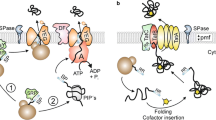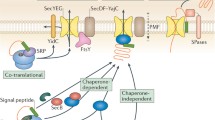Abstract
Positively charged amino acids are known efficiently to block protein secretion in Escherichia coli, when placed within a short distance downstream of a signal sequence. It is not known whether the same applies to protein secretion in eukaryotic cells, though statistical studies of signal sequences of prokaryotic and eukaryotic secretory proteins have suggested that the situation may be different in this case. Here, we show that identical charge mutations in a model protein have different effects on membrane translocation in E. coli and in mammalian microsomes, and that the ‘charge block’ effect is much more pronounced in the prokaryotic system. This finding has implications not only for our understanding of the mechanisms of protein secretion, but also points to a potential problem in the expression of eukaryotic secretory proteins in bacteria.
Similar content being viewed by others
References
Andersson H, von Heijne G (1991) A 30-residue-long “Export Initiation Domain” adjacent to the signal sequence is critical for protein translocation across the inner membrane of Escherichia coli. Proc Natl Acad Sci USA 88:9751–9754
Boyd D, Beckwith J (1989) Positively charged amino acid residues can act as topogenic determinants in membrane proteins. Proc Natl Acad Sci USA 86:9446–9450
Boyd D, Beckwith J (1990) The role of charged amino acids in the localization of secreted and membrane proteins. Cell 62:1031–1033
Dalbey RE (1990) Positively charged residues are important determinants of membrane protein topology. Trends Biochem Sci 15:253–257
Dalbey RE, Kuhn A, Wickner W (1987) The internal signal sequence of Escherichia coli leader peptidase is necessary, but not sufficient, for its rapid membrane assembly. J Biol Chem 262:13241–13245
Dalbey RE, Wickner W (1986) The role of the polar, carboxylterminal domain of Escherichia coli leader peptidase in its translocation across the plasma membrane. J Biol Chem 261:13844–13849
Dalbey RE, Wickner W (1987) Leader peptidase of Escherichia coli: critical role of a small domain in membrane assembly. Science 235:783–787
Dalbey RE, Wickner W (1988) Characterization of the internal signal-anchor domain of Escherichia coli leader peptidase. J Biol Chem 263:404–408
Erickson BW, Merrifield RB. (1976). Solid phase peptide synthesis. In: Hill RL, Neurath H (eds) The Proteins, vol. 2. Academic Press, London pp. 255–527
Geisselsoder J, Witney F, Yuckenberg P (1987) Efficient site-directed in vitro mutagenesis. BioTechniques 5:786–791
Johnston S, Lee JH, Ray DS (1985) High-level expression of M13 gene II protein from an inducible polycistronic messenger RNA. Gene 34:137–145
Kohara A, Yamamoto Y, Kikuchi M (1991) Alteration of N-terminal residues of mature human lysozyme affects its secretion in yeast and translocation into canine microsomal vesicles. J Biol Chem 266:20363–20368
Kozak M (1989) Context effects and inefficient initiation at non-AUG codons in eucaryotic cell-free translation systems. Mol Cell Biol 9:5073–5080
Kunkel TA (1985) Rapid and efficient site-specific mutagenesis without phenotypic selection. Proc Natl Acad Sci USA 82:488–492
Kusters R, Dowhan W, de Kruijff B (1991) Negatively charged phospholipids restore prePhoE translocation across phosphatidylglycerol-depleted Escherichia coli inner membranes. J Biol Chem 266:8659–8662
Laws JK, Dalbey RE (1989) Positive charges in the cytoplasmic domain of Escherichia coli leader peptidase prevent an apolar domain from functioning as a signal. EMBO J. 8:2095–2099
Li P, Beckwith J, Inouye H (1988) Alteration of the amino terminus of the mature sequence of a periplasmic protein can severely affect protein export in Escherichia coli. Proc Nat1 Acad Sci USA 85:7685–7689
Liljeström P, Garoff H (1991) Internally located cleavable signal sequences direct the formation of Semliki Forest Virus membrane proteins from a polyprotein precursor. J Virol 65:147–154
MacIntyre S, Eschbach ML, Mutschler B (1990) Export incompatibility of N-terminal basic residues in a mature polypeptide of Escherichia coli can be alleviated by optimising the signal peptide. Mol Gen Genet 221:466–474
Moore KE, Miura S (1987) A small hydrophobic domain anchors leader peptidase to the cytoplasmic membrane of Escherichia coli. J Biol Chem 262:8806–8813
Pugsley AP (1989) Protein targeting. Academic Press, San Diego
Summers RG, Harris CR, Knowles JR (1989) A conservative amino acid substitution, arginine for lysine, abolishes export of a hybrid protein in Escherichia coli — implications for the mechanism of protein secretion. J Biol Chem 264:20082–20088
von Heijne G (1984) Analysis of the distribution of charged residues in the N-terminal region of signal sequences: implications for protein export in prokaryotic and eukaryotic cells. EMBO J 3:2315–2318
von Heijne G (1985) Signal sequences. The limits of variation. J Mol Biol 184:99–105
von Heijne G (1986) Net N-C charge imbalance may be important for signal sequence function in bacteria. J Mol Biol 192:287–290
von Heijne G, Abrahmsén L (1989) Species-specific variation in signal peptide design: implications for protein secretion in foreign hosts. FEBS Lett 244:439–446
von Heijne G, Wickner W, Dalbey RE (1988) The cytoplasmic domain of Escherichia coli leader peptidase is a “translocation poison” sequence. Proc Natl Acad Sci USA 85:3363–3366
Wickner W (1988) Mechanisms of membrane assembly: general lessons from the study of M13 coat protein and Escherichia coli leader peptidase. Biochemistry 27:1081–1086
Wolfe PB, Rice M, Wickner W (1985) Effects of two sec genes on protein assembly into the plasma membrane of Escherichia coli. J Biol Chem 260:1836–1841
Wolfe PB, Silver P, Wickner W (1982) The isolation of homogeneous leader peptidase from a strain of Escherichia coli which overproduces the enzyme. J Biol Chem 257:7898–7902
Wolfe PB, Wickner W (1984) Bacterial leader peptidase, a membrane protein without a leader peptide, uses the same export pathway as pre-secretory proteins. Cell 36:1067–1072
Yamane K, Mizushima S (1988) Introduction of basic amino acids residues after the signal peptide inhibits protein translocation across the cytoplasmic membrane of Escherichia coli. J Biol Chem. 263:19690–19696
Zhu HY, Dalbey RE (1989) Both a short hydrophobic domain and a carboxyl-terminal hydrophilic region are important for signal function in the Escherichia coli leader peptidase. J Biol Chem 264:11833–11838
Author information
Authors and Affiliations
Additional information
Communicated by R.G. Hermann
Rights and permissions
About this article
Cite this article
Johansson, M., Nilsson, I. & von Heijne, G. Positively charged amino acids placed next to a signal sequence block protein translocation more efficiently in Escherichia coli than in mammalian microsomes. Molec. Gen. Genet. 239, 251–256 (1993). https://doi.org/10.1007/BF00281625
Received:
Accepted:
Issue Date:
DOI: https://doi.org/10.1007/BF00281625




